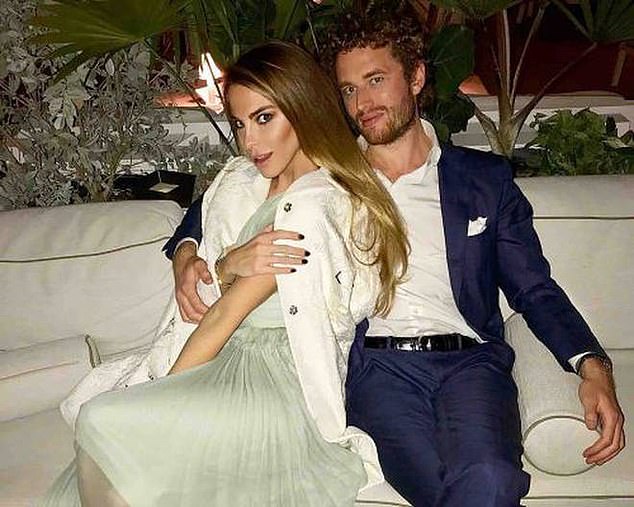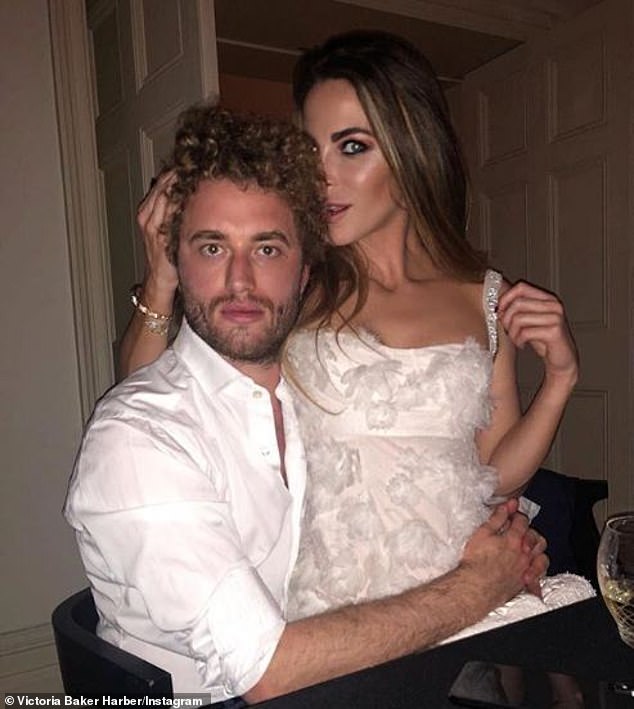Of all the places in the world you might expect to spot a Made In Chelsea star, Allenwood in Pennsylvania is surely not one of them.
Yet it was here, in this small rural pinprick on the United States map, that glamorous socialite Victoria Baker-Harber was spotted, awaiting the release of her art fraudster boyfriend from a prison which has three times as many inmates as the whistle-stop hamlet’s 314-strong population.
That ‘happy’ event finally took place earlier this year when, less than four years into his seven-year sentence, disgraced London-born art dealer Inigo Philbrick was released from Allenwood federal prison to ‘home confinement’, where he will be supervised, via an electronic ankle tag, for the next two years.
‘A long stretch, but here we are!’ Baker-Harber, 35, wrote on Instagram, alongside an apparently heart-warming image of herself and Philbrick on a picnic blanket with their adorable three-year-old daughter, Gaia, who was born while her father was in jail. No mention, of course, of 36-year-old Philbrick’s massive £80 million global art fraud — or his dozens of devastated victims.
While many of them are still trying to claw back the fortunes they lost, he and Baker-Harber are moving on with their lives.
Aside from an interview with the magazine Vanity Fair, in which an unabashed Philbrick expressed his desire to return to his career as an art dealer, there’s a three-part documentary in the works.


Titled The Real Story Of Inigo Philbrick: A Tale of Fraud, Fame And Fortune, and expected to air on the BBC this summer, it boasts ‘exclusive access to the convicted contemporary art dealer Inigo Philbrick and his fiancée’.
It will also take in the couple’s flight to the Pacific islands of Vanuatu, where the FBI tracked him down in 2020 after he spent six months on the run.
Is there any sign of contrition? Not a bit. ‘He didn’t murder anyone,’ Baker-Harber, a well-spoken swimsuit designer, told the Mail last year at a red carpet event in London.
‘He put his hands up and admitted what he did do, and takes full responsibility and accountability, but everyone makes mistakes,’ she said.
Alas, those Philbrick defrauded, including a Saudi royal and the London auction house Christie’s, are not quite so ready to forgive — nor forget — the way he swindled them by selling the same valuable masterpieces several times over to different investors, then using their cash to fund his own lavish, jet-setting lifestyle.
J udd Grossman, a U.S. lawyer representing several of Philbrick’s former clients, told the Mail this week that they were ‘close confidants, business and personal contacts of Philbrick, who depended on him and trusted him’.
‘When they learned he had betrayed their trust, it hit them all very hard,’ said Grossman, who specialises in art litigation.
Many are also furious that, while they have yet to get back the millions they lost, the former Mayfair gallery owner wasted no time touting his story around, even before he was released from jail.
Aside from the BBC series, Hollywood producers are also said to be vying for film rights to Philbrick’s saga. There is talk, too, of a Netflix-style drama series.
‘Fraudsters are charming,’ says Robert Wittman, founder of the FBI’s National Art Crime Team, adding: ‘These kinds of people come across well on screen.’
The thrill at the heart of Philbrick’s story, of course, is his love affair with Baker-Harber and their adventures together as he fled his life of crime.
Indeed, the last time the couple were together on the outside was on the Tarmac at Vanuatu’s Bauerfield International Airport in June 2020 where Baker-Harber, who was five months pregnant, was held down by heavies while she watched in horror as her lover, in swimming shorts and espadrilles, was bundled into a Gulfstream jet chartered by the FBI.
Philbrick was taken first to Guam, a U.S. island in the Pacific Ocean, and then to New York, bringing to an end an extraordinary six months which saw the pair living under the radar in a run-down beachside boat house.

By the time Channel 4’s Made In Chelsea returned for its 23rd series in the spring of 2022, designer-clad Baker-Harber had effortlessly stepped back into her swanky London life with a baby in tow.
Asked ‘Where’s Gaia’s dad?’ by a fellow cast member, she replied with a nervous chortle: ‘He’s incarcerated right now, like awaiting sentencing. It’s financial, white-collar stuff. Unfortunately he’s being held in a place which is like maximum security. I’ve only seen him once since all of this has happened and he was shackled.’
Joking that he looked good in his prison uniform, Baker-Harber added that orange ‘is not really his colour; he was in a sort of khaki jumpsuit. It has a collar at least’.
She told the Mail at the time: ‘I’ve supported Inigo from the moment he was in trouble. To abandon someone at their lowest point isn’t my way.’
Meanwhile, Philbrick was behind bars at the infamous Metropolitan Detention Center in New York, where, the Mail has discovered, he was locked up with Jeffrey Epstein’s former cellmate, ‘killer cop’ Nicholas Tartaglione, who murdered four men after accusing one of them of stealing.
Heaven knows what Tartaglione must have made of Philbrick, who had magazines Country Life and The Economist delivered to his cell. But this bizarre interlude will no doubt provide additional colour for any forthcoming TV show.
Philbrick’s years of captivity are a stark contrast to the world he and Baker-Harber inhabited when they met, in August 2016, on board a luxury yacht, anchored off the island of Corsica and chartered by one of his future victims, London-based art investor Sasha Pesko.
Philbrick was on board with his former girlfriend, Argentinian Francisca Mancini, who was soon to give birth to his first daughter.
Baker-Harber, the eldest of three daughters born to the late Olympic sailor and maritime lawyer Michael Baker-Harber and his wife Anna, says her first reaction was that Philbrick ‘wasn’t her type’.
Philbrick, for his part, was smitten. ‘She staggered me,’ he told Vanity Fair magazine. After months of texting, she relented and agreed to meet.
Describing how Philbrick leaned over and kissed her while showing her around his swanky Mayfair gallery, Baker-Harber enthused: ‘He could hold an entire room in awe just by discussing the context of an artist’s work or what it represented. From that point forward, we were together nonstop.’
But it was precisely this charm and magnetism that made Philbrick so plausible to potential victims.
As former FBI art crime investigator Robert Wittman puts it: ‘They seem knowledgeable but they’re using knowledge and charm to convince people to invest with them. That’s what a good scammer does. It’s what we call ‘befriending and betraying’.’
Philbrick, the son of American artist turned museum director Harry Philbrick and his ex-wife Jane, a Harvard-educated writer and artist, was seen as the ‘wunderkind’ of the London art world, with businesses bringing in annual sales of around £80 million.
Raised in the U.S., in 2005 he followed in his father’s footsteps by studying art curation at the University of London. In 2010, he was taken on as an intern at the city’s prestigious White Cube gallery.
T he gallery’s founder, Jay Jopling, who would also become one of Philbrick’s victims, was impressed by the bright, sophisticated young man who came to work for him.

Within a year, Philbrick was made director of secondary market sales, reselling pre-owned artworks to both investors and collectors and taking commission.
With Jopling’s backing, he opened his own gallery in Mayfair in 2013. A second ‘Inigo Philbrick’ gallery opened in Miami in 2018. Many of his clients were what the art world calls ‘specullectors’, who purchase artworks, or a share in them, as investments, sometimes without seeing them. They split their profits with Philbrick when he resold them at a higher price.
For a time — before he got greedy — he was the toast of the art world, cutting a swathe through London, New York and Miami society with statuesque Baker-Harber on his arm. He was flying around the world on private jets, spending summers in Ibiza and winters in the ski resort of St Moritz.
He wore £5,000 suits, hand-stitched shoes, had a diamond in the pin of his belt and a £48,000 watch. He drank £5,000 bottles of Chateau Petrus and took drugs because, as his lawyer put it, that was ‘how art deals are done’.
But he began lying to clients about ownership and prices of artworks, selling more than 100 per cent of several of them to multiple investors, borrowing money against art he didn’t own and misappropriating sales proceeds, as well as forging contracts and documents to try to inflate artwork values and cover his tracks.
‘He was pyramid-scheming the artwork to steal money. He was basically skimming off the top,’ explains Wittman.
Paintings worth millions caught up in Philbrick’s fraud include works by the late Jean-Michel Basquiat and Italian photo-realist artist Rudolf Stingel.
It was a 2012 painting of Picasso by Stingel which signalled Philbrick’s downfall when, having sold multiple competing shares, including to Sasha Pesko, it realised a disappointing £5.3 million at auction.
In October 2019, as panicked clients scrambled to recover money and assets and launched civil lawsuits for fraud, Philbrick vanished with Baker-Harber. She told Vanity Fair that she never understood ‘the intricacies of art world finance’. There is no evidence that she was involved in, or knew of, Philbrick’s crimes.
The couple flew to Sydney. Then, in January 2020, they arrived in remote Vanuatu, which has no extradition treaty with America.
What followed were an idyllic few months in an exotic island paradise where, for a time, the pair lived a simpler life, lounging on palm tree-fringed beaches and eating local food. Living in plain sight under his own name, Philbrick booked tennis lessons and visited the same coffee shop each morning. He and Baker-Harber rescued stray dogs and adopted one of their own.
This idyll came to a crashing end in June 2020 while the pair were wandering through a market in the capital Port Vila, looking, they told Vanity Fair, for ‘amazing green tea taro cake’, when men in flak jackets appeared and hustled Philbrick into a waiting car.
In November 2021, he pleaded guilty to federal wire fraud charges, telling a Manhattan judge he had done it ‘for the money’. He was sentenced to seven years in jail.
‘Inigo is the love of my life and I simply cannot function without him,’ Baker-Harber told the court while pleading on her lover’s behalf. It will make a fine line in the mouth of whichever actress ends up playing her.
Indeed, she helped Philbrick write the treatment for the new TV series, described as ‘a love story that spanned multiple countries, multi-million-dollar art deals, and an international manhunt ending in an exotic South Pacific archipelago’.
Meanwhile, the problem for his victims, says lawyer Judd Grossman, is that they ‘don’t seem on paper to be the most sympathetic’. He added: ‘They’re wealthy. They’re sophisticated. And people reading these stories don’t shed a tear over their losses of millions of dollars, considering they are still going to be OK.

‘But what gets overlooked is that any time someone is a victim of a fraud there is a feeling that you’ve been betrayed and, in many ways, that can be worse than the loss of money.’
Daniel Tumpel, owner and founder of Fine Art Partners (FAP) in Germany, was one of Philbrick’s major victims. He had invested close to $18 million.
‘This is not a Robin Hood story,’ he wrote in a victim impact statement. ‘This is real money he stole. Money my wife and I had worked hard for during our work life and which Philbrick embezzled to finance the luxurious lifestyle, the private planes, the gambling and the heavy spending on wine, drugs and restaurants.
‘Philbrick’s criminal activities have led to an immense financial loss for us, and I can assure you they turned the last two-and-a-half years into the most horrendous and difficult years of our lives.
‘He betrayed everyone he had ever worked with. Inigo Philbrick is a stone-cold criminal, who was driven by greed and the wish to finance his lavish lifestyle.’
Another of those he defrauded is art investor Andre Sakai, godfather to his eldest daughter.
Personal betrayals aside, to many his case is evidence of the risks of an unregulated market where multi-million-pound deals can be done in virtual secrecy.
‘The opaqueness of the art world lends itself to the committing of fraud,’ says Wittman. ‘It’s like the Wild West. There’s not a whole lot of information going around about who’s got what and how much they’re paying for it.’
And while there’s nothing to stop Philbrick re-establishing himself as an art dealer, Wittman says ‘the U.S. Attorney’s office will be watching’, given he still owes $86,672,790 in restitution. ‘If they start seeing big income, they’ll start seizing his assets.’
As for Baker-Harber, her profile has never been so high. Her Instagram account, replete with glossy photographs of herself in exotic locations, has been inundated with messages of support from fans following every twist and turn of her romance with a man guilty of one of the biggest art frauds in history.
‘You deserve the entire love story,’ says one of hundreds of messages. Another reads: ‘Time for a wedding! Have it on Made In Chelsea.’ A third: ‘Finally, the next chapter of your love story can begin.’
Distasteful as it might be for Philbrick’s victims, there are plenty clamouring for the glitzy, globe-trotting tale of the fraudster and the devoted moll who kept her promise to wait for him.
This post was originally published on this site be sure to check out more of their content.






